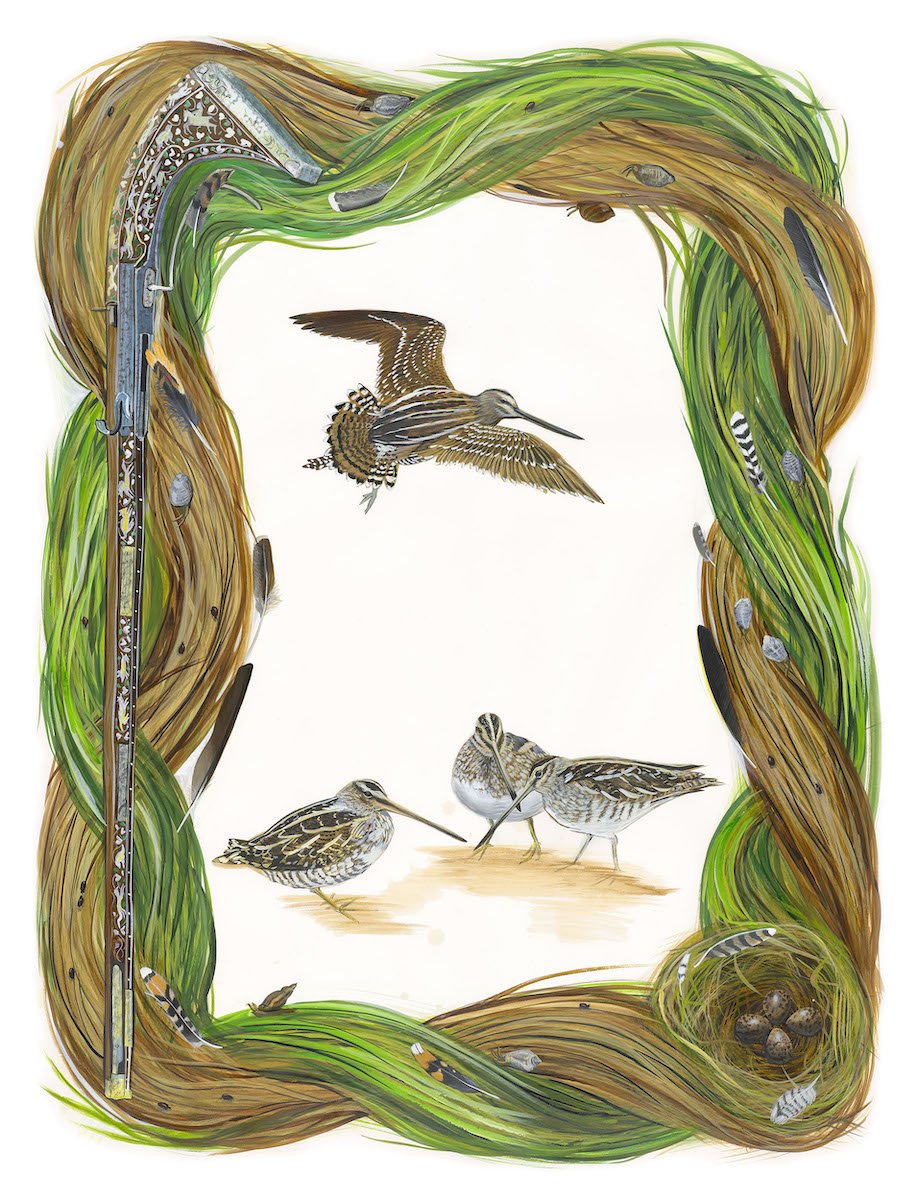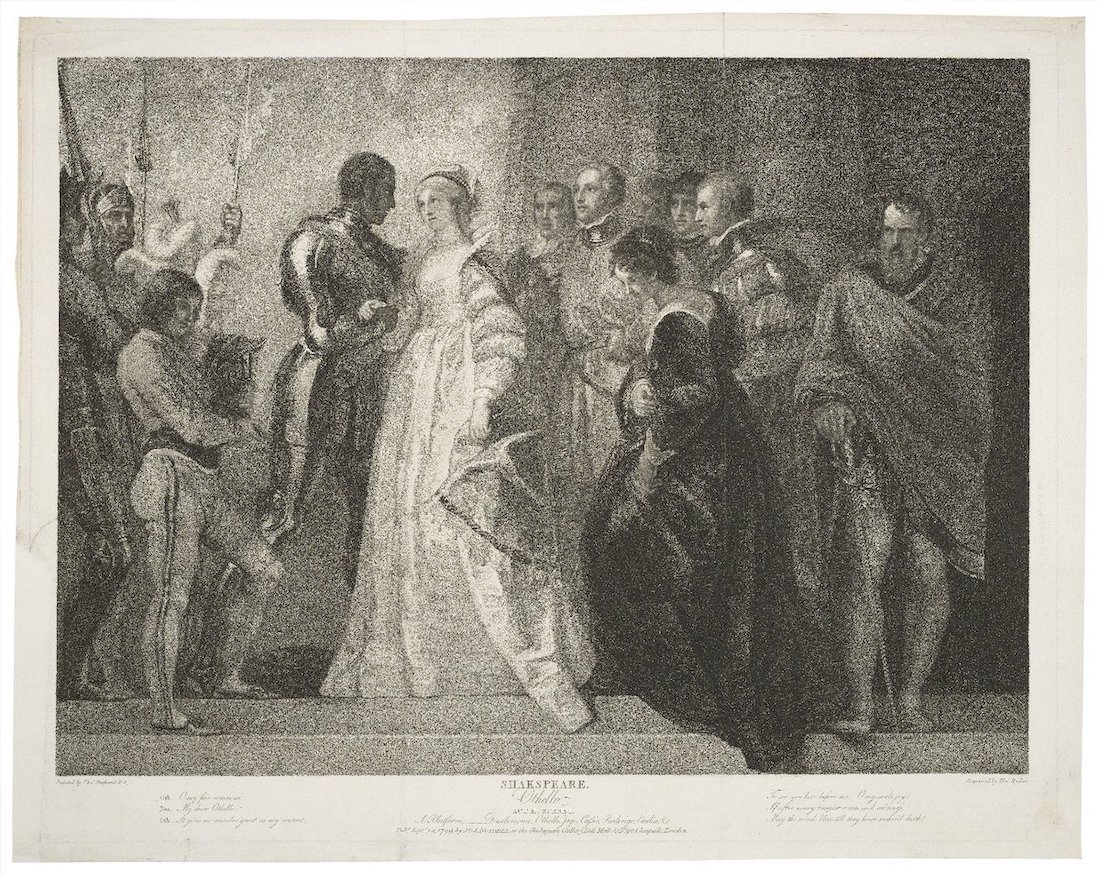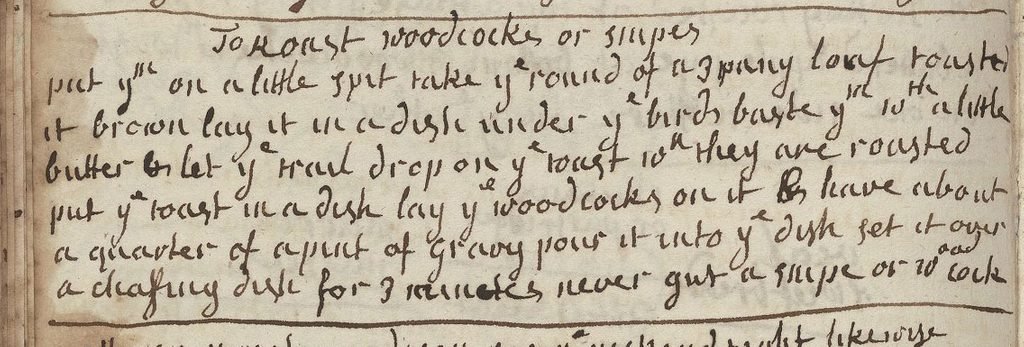Common Snipe (Gallinago gallinago)
Painting by Missy Dunaway. Created with acrylic ink on paper. 30x22 inches (76x56 cm)
Painting Key
Fauna: 4 common snipes (Gallinago gallinago), prey: 9 marsh periwinkle snails (Littoraria irrorate) and 13 marsh beetles (Contacyphon padi)
Flora: Marsh grass
Objects: 4 common snipe eggs in nest, 13 common snipe feathers, 1 hunting rifle (Petronel) c. 1550-1599[1]
Plants mentioned by Shakespeare: Grass
Shakespeare’s Snipe
Occurrences in text: 1
Plays: Othello
Name as it appears in the text: “snipe”
It’s snipe hunting season! No, I do not mean mythical snipe hunts meant to preoccupy American children. In Shakespeare’s world, “snipe” refers to the common snipe, or Gallinago gallinago, in the wader family of sandpipers. The American snipe is the basis for a 19th-century practical joke, where an unwitting victim is sent to pursue something that doesn’t exist.[2] The common snipe found in European marshes is just as challenging to catch.
Snipes are small, plump waders with the longest beak-to-body ratio of all European birds.[3] They have sensitive, flexible beaks that probe marsh mud for insects and small mollusks to eat. The tip of their beaks can open and close independently, allowing them to eat with the beak submerged in mud. The beak may be the origin of the snipe’s name. The Old English “snite” and Middle English “snype” is related to the word “snout.”[4]
The snipe can be prey in falconry, particularly for a merlin, but it is a challenging target.[5] It is difficult to catch because its plumage camouflages excellently into tall marsh grasses. When startled, it bursts out of vegetation, shooting off at 60 miles an hour in flight. Its chaotic, zig-zag flight pattern makes hunting with a gun incredibly challenging. Since it is such a testing target, the word “snipe” was the basis for the term “sniper.”[6]
The snipe appears and vanishes in Shakespeare’s landscape just as quickly as in its natural habitat. We find it in Othello, in a line from Iago about the gullible Roderigo. Iago and Roderigo share a hatred for Othello and hatch a plan to destroy his marriage to Desdemona. Iago manipulates Roderigo’s love of Desdemona to get him to assist in his evil scheme. However, Iago makes it clear to the audience that he would never trifle with such a fool as Roderigo if he didn’t have something to gain from it. Iago refers to Roderigo as a snipe to describe someone who is a waste of time, and a sportsman only pursues a snipe for “sport or profit.”
Othello, Act I, Scene 3, Line 407
IAGO: Thou art sure of me. Go, make money. I have
told thee often, and I retell thee again and again, I
hate the Moor. My cause is hearted; thine hath no
less reason. Let us be conjunctive in our revenge
against him. If thou canst cuckold him, thou dost
thyself a pleasure, me a sport. There are many
events in the womb of time which will be delivered.
Traverse, go, provide thy money. We will have more
of this tomorrow. Adieu.RODERIGO: Where shall we meet i’ th’ morning?
IAGO: At my lodging.
RODERIGO: I’ll be with thee betimes.
IAGO: Go to, farewell. Do you hear, Roderigo?
⟨RODERIGO: What say you?
IAGO: No more of drowning, do you hear?
RODERIGO: I am changed.
IAGO: Go to, farewell. Put money enough in your
purse.⟩[RODERIGO: I’ll sell all my land.] He exits.
IAGO: Thus do I ever make my fool my purse.
For I mine own gained knowledge should profane
If I would time expend with such ⟨a⟩ snipe
But for my sport and profit.
Although snipe hunters today use guns, in Shakespeare’s day guns were fired by lighting a flint and would therefore struggle to shoot a snipe down from its erratic flight. Instead, hunters would catch snipes with traps and nets to sell them at market for household meals.[7] I found one snipe recipe from 1740 in the Folger’s collection, penned by a Mrs. Knight:[8]
To Roast woodocks or snipes
put them on a little spit take the round of a 3 pany loaf toast[ed]
it brown lay it in a dish under the birds baste them with alittle
butter & let the trail drop on the toast when they are roasted
put the toast in a dish lay the woodcocks on it & have about
a quarter of a pint of gravy pour it into the dish set it over
a chafing dish for 3 minetes never gut a snipe or woodcock.
The snipe is the eighteenth character to join our flock of Shakespearean birds. Thank you for following along with this series! Next month we will meet the crow.
Endnotes
[1] “Gun (Petronel)”. 1550-1599 (made).M.485-1927, Metalwork Collection. Victoria and Albert Museum, London, UK.
[2] Brunvand, Jan H. American Folklore: An Encyclopedia. Taylor & Francis, 1996. p. 233.
[3] Greenoak, F., All The Birds of the Air, 2nd ed, (Middlesex: Penguin Books Ltd., 1981), 119.
[4] Greenoak, F., All The Birds of the Air, 2nd ed, (Middlesex: Penguin Books Ltd., 1981), 119.
[5] Harting, J., The Birds of Shakespeare, (London: John Van Voorst, Paternoster Row, 1871), 57.
[6] Pegler, Martin. Out of Nowhere: A History of the Military Sniper. Osprey, Oxford, 2004.
[7] Harting, J., The Birds of Shakespeare, (London: John Van Voorst, Paternoster Row, 1871), 57.
[8] Mrs. Knight's receipt book [manuscript], 1740. Folger Shakespeare Library, Washington DC.


